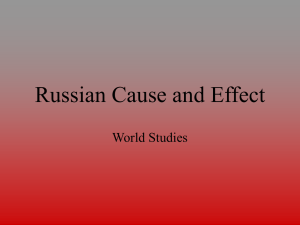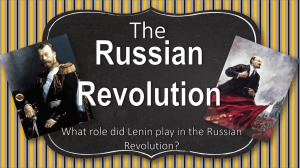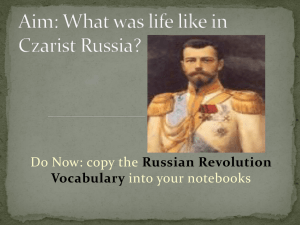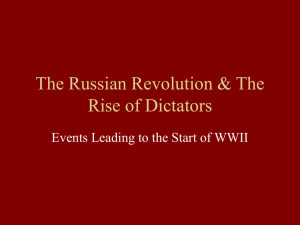Russian Revolution 1917-1938
advertisement
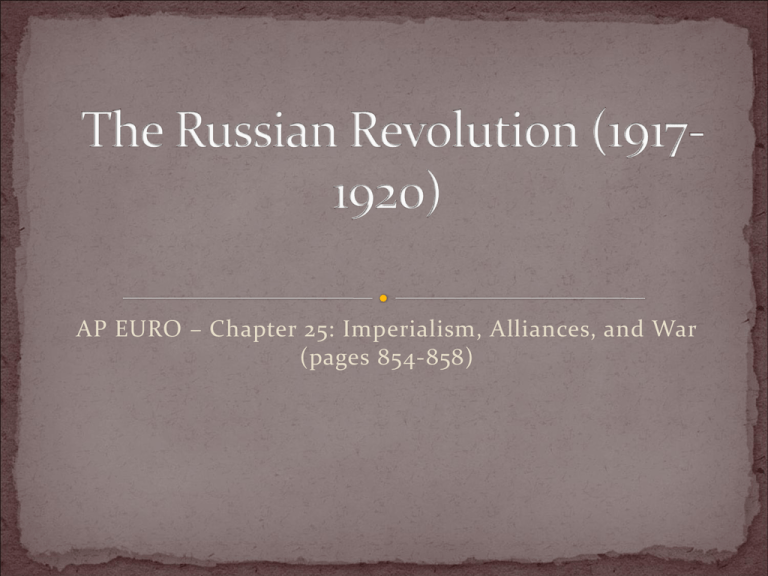
AP EURO – Chapter 25: Imperialism, Alliances, and War (pages 854-858) 1. Multi-Ethnic & Diverse 2. Multi- Cultural 100 different languages spoken by the people throughout the Russian Territory Various faiths Type of Government: “AUTOCRACY”- government in which 1 person rules with unlimited authority Ruler: CZAR- means “emperor” or “monarch” derived from “Caesar” 1. Peter the Great – ruled: 1682-1725 Modernized Russia Built St. Petersburg 2. Catherine the Great – ruled : 1762-1796 Territorial expansion Suppressed Pugachev’s Rebellion (1773-1775) an uprising of serfs Official residence of monarchs 1732- 1917 Serf – a Russian peasant legally bound to reside and work on “lord’s” land “Un-free” status Bound peasants to rural areas and to their land lord Napoleon invaded Russia in the winter Russian Soldiers were exposed and influenced by Western ideas during Napoleonic wars “Secret Societies” emerged: wanted economic reform, a constitutional government, AND freedom for serfs Strengthened the autocracy (his power) by: 1. Censoring the Press 2. Establishing a “Secret Police”- allowed to arrest & imprison people without trial 3. “Autocracy, orthodoxy, and nationality!” -CNI He was Alexander I’s brother-> The Decembrist Revolt (1825) – A group of military officials rebelled and staged a coup Felt threatened by Czar Nicholas I’s conservative views http://www.youtube.com/watch?v=rXPP1j1yahg Czar Alexander II http://www.youtube.com/watch?v=8PFQ7Th_rAs “The Czar Liberator” 1. 1861 signed Emancipation Manifesto - granted Freedom to serfs 2. Limited the authority of secret police 3. Modernized judicial system 4. expanded education 5. re-organized the Russian army 6. Reduced military service from 25 yrs to 6 yrs 7. Promoted industrialization 95% of population were peasants, most serfs. Free serfs received no land, had no skills. Found themselves homeless and unemployed Landowners were furious - they lost land & power Radical Revolutionaries… 1. Shot at Alex II (bullets missed him 1879) 2. Bombed Alex’s train (he survived 1879) 3. Bombed palace 1880 (he survived) 4. Threw bombs at his carriage Alex II survived initial threat… but then Stepped out of his carriage and died in 1881 http://www.youtube.com/watch?v=8PFQ7Th_rAs Established a rule of fear 1. “Russification”- persecuted those who anyone who spoke a language other than Russian or followed a religion other than Eastern Orthodoxy 2. Established “Pogroms”- organized massacres of minority groups Inherited Russia’s long history of social and political problems Not prepared to rule Wife Empress Alexandra 4 Daughters: Olga, Tatiana, Maria, Anastasia 1 Son : Alexis Suffered from “Hemophilia” – a Disease which prevents normal clotting of blood No known treatment Disease kept secret from public Named RASPUTIN * Self -proclaimed monk & mystic Healer * Empress hired him to “heal” son He was not who he appeared to be!!! Influenced Czar Nicholas II politically Workers’ Peaceful march to St. Petersburg turned violent Protested food and fuel shortages Soldiers opened fire to unarmed crowd Russian press claimed 100 died, many wounded Protestors claimed 1,000 died Russia and Japan fought over the province of Manchuria Russian Ships vs. Japanese ships Japan sanks2/3rds of the Russian fleet Humiliating defeat for Czar Nicholas II Czar Nicholas II Promised Reforms 1. Constitution 2. Civil Liberties/ Civil Rights and a 3. Duma or legislature http://www.youtube.com/watch?v=P-x4VcmHfxU Continued to influence Czar Nicholas II and the+ Czarina Claimed he “cured” son’s hemophilia People were skeptical of Rasputin … 1916 nobles planned his assassination They Poisoned him at dinner… He survived! They Shot him… Still alive! They Beat him with a candlestick! He was Not dead yet! Rasputin was thrown into an icy river… He was still breathing. http://www.youtube.com/watch?v=1W1b6j8U46k Socialism – belief that the means of production capital, land, raw materials, factories should be owned and controlled by society, not individuals Communism – a society without class distinctions or private property (equality ) “History advances through conflict” The Class that controls production is the ruling class This causes the gap between social classes Competition causes society’s problems Believed the Working class should lead revolution and seize control Led by Vladimir Ilyich Ulyanov “Lenin” Goal : to create a socialist state with no social classes, no private property Food riots in St. Petersburg Czar Nicholas II ordered Duma (legislative body) to dissolve Czar ordered troops to suppress disorder Neither obeyed the Czar Czar Nicholas II abdicated the Throne Family was Evacuated in August March 17, 1917 Russia Proclaimed a republic Provisional government was established Overthrew the provisional government in November , 1917 “History will not forgive us if we do not seize power now”-Lenin Lenin Claimed absolute power A Socialist State based on ideas of Karl Marx, and Lenin 1. land re-distributed amongst peasants 2. End of private ownership of property 3. Workers gained control of property “equality” Re-named their political party the Communist party in 1918 1918-1920 civil war ensued in Russia Communists “Reds” vs. “Whites” (Royalists) Fought over political control What about the Romanovs? Was Imprisoned in Ipatiev House Forced to give up luxuries Believed they would be rescued were they??? 2:33 am Romanov family Their Doctor & 3 servants were shot in a basement The Assassination ordered by Lenin http://www.youtube.com/watch?v=B-qxWWRcN-4 Did She Survive? In 1920 in Berlin Germany A girl tried to jump off a bridge was rescued no I.D., refused to give her identity Sent to mental asylum Claimed to be “Anastasia” Said she was Rescued by a soldier And escaped Russia “She is similar, she is similar” Relatives were careful to believe her story Supporters helped her Anna Anderson claimed she was Anastasia until the day she died (1984) 1977 court ruled not enough evidence to prove identity Recent DNA testing proved she was not Anastasia Romanov Family’s bodies were exhumed from their graves 2 bodies missing !! Anastasia or Maria ? And Alexis 1998 remains were given proper burial 2 Remains were discovered By workers digging a ditch in Russia – close to where the original remains were buried Actual remains found in 2007 DNA test results in 2008 concluded that the remains were Alexis and Anastasia Achieve “Sainthood” In Russian Orthodox Church, 2000 Considered Martyrs Anastasia, 1956 Set in Paris 1928 Russian immigrants Transform a confused Russian girl in an asylum into the Grand Duchess Anastasia in order to claim reward Anastasia, 1997 “I just want to know who I am, if I am part of a family” Orphan with amnesia Dmitri & Vlad transform confused girl into Anastasia Take her to Paris to reunite with Grandmother 1. Long period of social repression & political unrest 2. “Bloody Sunday” incident 1905 3. Disastrous loss for Russia Russo-Japanese war 1905 4. 1917 March Revolution – food riots, no one obeyed Czar Nicholas II AP European History Lenin and Communist Party Gained absolute power in 1918 defeated the Royalists in 1920 Established socialist state No private property, no social classes “War Communism” State took control of the economy Complete social & economic overhaul People worked for the good of the whole, (community/nation) instead of themselves Of agriculture began in 1928 Crops are turned over to the state Peasants were paid in crops, rather than money Millions of peasants starved When Army confiscated grains and other products for re-distribution “ The Soviet Union” / U.S.S.R Adopted constitution based on dictatorship An elaborate tomb was built Lenin was displayed for “worship” in a glass coffin Who should take his place? Leon Trotsky or Joseph Stalin? Placed supporters in top jobs Managed to spread rumors about Trotsky Stalin gained control, and threatened Trotsky Trotsky fled into exile 1929 Stalin sent an agent to murder Trotsky Trotsky died in Frida Kahlo’s house Mexico City, 1940 1928: 1. to Build heavy industry 2. to Improve transportation 3. to Increase farming output 1928-1939 large factories, hydroelectric power stations, industrial complexes, railroads built Standards of living remained poor Some received food, some did not Joseph Stalin’s “reign of terror” Persecuted 4 million people 800,000 executed Accused of being “counter revolutionaries”, anyone who disagreed with his rule, anyone who was seen as a threat Atheism became official policy Churches of any kind were banned Religious leaders of various faiths persecuted Did people become atheist overnight? Ensured Stalin’s political power Government controlled everything! what books are read to what music was heard! The complete opposite of Freedom Massive propaganda Showed Soviet life in positive light Showed 1 perspective Free education for all (however, occupation was chosen for the student) Free medical care Women won equality under the law In 1991 Independent countries were formed Russia is the largest Total control over the lives of individual citizens Forms of totalitarianism: 1. Communism (Soviet Union) 2. Fascism (Italy) 1. Single party Dictatorship 2. State control of Economy 3. Police spies 4. Strict Censorship 5. Use of schools & media to indoctrinate citizens 6. Unquestioning obedience to single ruler Fascists were: anti-democratic, anti-communist anti-parliamentary anti-Semitic Established Totalitarian Rule Founded National Fascist Party 1919 1921 elected to Italian Parliament 1922 appointed Prime Minister 1924 Fascist Party crowd favorite Had elections, but outlawed all other political parties 1. Severe economic crisis (Economic inflation, depression, unemployment) 2. The loss of 600,000 lives 3. “ little territory compensation” at the end of WWI 4. Peasants wanted land 5. Middle class feared a communist revolt 1. his “Thundering speeches” 2. his Confident Strut 3. his image - Always wore military uniform (had little or no real military training) 1.Lateran Agreement 1929- Vatican became independent of Italy 2. Women seen as “second class citizens” encouraged to stay home, produce large families 3. Divided aspects of the Economy into 22 areas or “corporations” (think Hunger Games) 4. Government dictated –working conditions, policies, wages, prices Provisional Government in place after WWI New Constitution July 1919 adopted in city of Weimar Weimar Republic lasted until Hitler came to power 1933 Failed due to: Political instability Severe economic inflation (money lost its worth) 1920’s Severe economic depression 1930’s January 1919 Uprising led by Russian Communists Rosa Luxemburg & Karl Liebknecht Belonged to Spartacus League Jan. 1919, Berlin Provisional Government crushed rebellion 1/13/1919 Rosa Luxemburg and Karl Liebknecht executed without trial on 15th January, 1919 1920, Berlin Led by conservative govt. officials Supported by angry army officers Tried to overthrow the Weimar Republic government Coup failed Germany could not meet reparations payment (WWI) Britain & France under pressure to repay the U.S. Could not pay the U.S. unless Germany payed them… Britain & France wanted Germany to pay in natural resources French Premiere Raymond Poincare threatened to occupy the “Ruhr Basin” A German mining & steel center 1923 German Government ordered factory workers to quit French, Belgian troops mobilized Germany printed more $ to pay off unemployed workers =inflation League of Nations: Reworked Germany’s reparations payments Germany was furious at the international community who blamed them for WWI They owed $35 million in war reparations AP EURO Stock market crash in the U.S. affected European economy Americans: 1. Stopped investing in Europe 2. Stopped purchasing foreign goods 1. Grain prices plummeted 2. Farmers could not repay debt, or purchase goods 3. Overproduction & low prices 4. Widespread unemployment 5. Inflation Kreditanstalt Large bank in Vienna collapsed Primary lending institution central & Eastern Europe Collapse Placed pressure on German banks The Worst of the Economic Depressions Middle Class lost faith in economic system, feared communism People sought strong leader Ran for President in 1932 He lost 13 million votes vs. 19 million President Hindenberg named him Chancellor in 1933 40 Years old versus , Hindenberg who was 80 40% of the party under 40 Ideas of national recovery, rapid change, personal advancement appealing to a desperate population Delivered a scapegoat Hitler 1. Captured full legal authority 2. Crushed opposition 3. Purged Nazi party of rivals Police surveillance “Protective Force” 1933 = 52,000 members Heinrich Himmler, Commander Burned down in 1933 Hitler blamed the “communist threat” Used the incident to pass Enabling Act (1933)suspends individual rights for those accused of crimes *Allowed Hitler to rule by Decree Boycotts against Jews Jews fired from government jobs including teachers, University Professors, Doctors, Lawyers, etc. Jews fired from jobs in radio, theatres, and art Books written by Jews burned in bonfires Prohibited from owning land Defined “Jewish” as having at least 1 Jewish grandparent No religious connotation Legal basis for discrimination Deprived Jewish community of citizenship rights Marriage between Jews & “non” Jews banned Yellow star of David In Germany!! Hitler relaxed anti- Semitic measures to avoid criticism from visitors Anti-Semitic (anti Jewish) violence, confiscation of property, All Jews have to add “Sarah” and “Israel” to their I.D. papers Jews banned from attending plays, concerts, having driver’s licenses. Persecution increased Nov. 9-10 Nazis burned & destroy ed thousands of Jewish homes & businesses, temples “night of broken glass” 100 Jews killed 7,500 Jewish homes, businesses destroyed Hundreds schools, cemeteries, synagogues vandalized 30,000 Jews arrested Jewish shops ordered to close by December 31st, 1938
